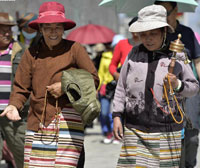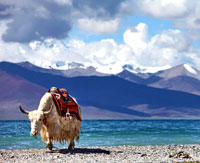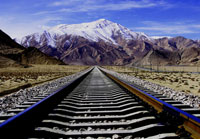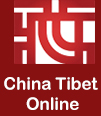About Tibet
Location: Located in the southwest part of the Qinghai-Tibet Plateau, the Tibet Autonomous Region (Tibet for short) borders on Sichuan and Yunnan provinces to the east, Qinghai Province and Xinjiang Uygur Autonomous Region to the north, and shares borders with India, Nepal and Burma to the south, and bounded by Kashmir to the west.
Area: The region covers more than 1,228,400 square kilometers, accounting for one eighth of China's total land mass, and ranking second in China.
Geography: The region has various complex landforms such as high and steep mountains, deep valleys, glaciers, bare rocks and gobi deserts. All places in the region lie at an average altitude of more than 4,000 meters.
It is roughly divided into four areas: the north Qinghai-Tibet plateau, the south Tibet valley, east Tibet mountains and valleys, and Himalaya Mountains.
Climate: It is bitterly cold in winter, with a marked difference in temperature between daytime and night. It features scarce precipitation and a sharp contrast between the dry and wet seasons. It is dry in winter and spring, with frequent occurrence of strong winds, as well as low oxygen content.
Tibet is so sunny as to have an annual sunshine of between 1,500 and 3,400 hours. It has a short frost-free period, usually ranging from 120 to 140 days a year.
Population: In 2013, the population of Tibet rose to 3.1204 million, and average life expectancy was 68.2 years.
In Tibet there are Tibetans, Monbas, Lhobas, Naxi's, Huis, Han's and peoples of some other ethnic groups; they all enjoy the right to equally participate in the administration of state affairs.
Provincial Capital: Lhasa
Administrative Division: It is divided into 4 cities, 3 prefectures, and 76 counties.
Language: There are three Tibetan dialects, namely, Zang, Khampa and Amdo.

Culture: Tibet has 4,277 cultural relic sites, including 55 key cultural heritage sites under state protection, 391 under regional protection, and 978 under city- or county-level protection, as well as three state-level historical and cultural cities (Lhasa, Shigatse and Gyangtse).
Citizens enjoy full freedom of religious belief. In Tibet, Tibetan Buddhism, Bon, Islam, and Catholicism coexist with a number of other religions, and within Tibetan Buddhism there are different sects such as Nyingma, Kagyu, Sakya and Gelug.
Tibet has also succeeded in preserving the spoken and written Tibetan language.

Life: In 2013, the Gross Regional Product (GRP) of Tibet reached 80.767 billion yuan; the per-capita net income of farmers and herdsmen was 6,578 yuan and the per-capita disposable income of urban dwellers was 20,023 yuan. The overwhelming majority of Tibetans have now shaken off poverty that had dogged them for centuries to enjoy a relatively comfortable life. The low-income housing projects for farmers and herdsmen that were initiated in 2006 have been completed, and a total of 460,300 low-income houses were built, providing safe modern housing to 2.3 million farmers and herdsmen. The average per-capita floor space of farmers and herdsmen was 30.51 sq m, and that of urban dwellers reached 42.81 sq m.

Travel: Tibet is gifted with gorgeous natural landscape and rich cultural scenery. Tibet has a number of national-level cultural relics such as the Potala Palace, the monasteries of Jokhang, Tashilhunpo, Sagya, and Drepung, the ruins of the ancient Guge Kingdom, the Tombs of Tibetan Kings and others. There are numerous sites and objects in Tibet gaining the title of "Number One" in China, Asia, or even the whole world.

Economy: Modern industry and infrastructure are improving rapidly. A distinctive modern industrial system has been established that is adapted to the needs and conditions in Tibet and comprises more than 20 industries, in addition to the full development of a new energy system that is based on hydraulic power features complementation of geothermal, wind and solar power as well as other new energy sources. Tibet has gradually evolved from being a closed type to being one that is open and market-oriented. Tibet has been fully incorporated into the national market system.
Tibetan-inhabited areas in other four provinces of China
Sichuan
Sichuan has two Tibetan autonomous prefectures:
Aba Tibetan-Qiang Autonomous Prefecture
The prefecture has an area of 84,200 square kilometers and a population of 851,000 with 54.5 percent of them ethnic Tibetans.
For more information in Chinese please check: http://www.abazhou.gov.cn
Garze Tibetan Autonomous Prefecture
The prefecture has an area of 151,078 square kilometers and a population of 914,000 with 78.9 percent of them ethnic Tibetans.
For more information in Chinese please check: http://www.gzz.gov.cn
Gansu
Gansu has one Tibetan autonomous prefecture:
Gannan Tibetan Autonomous Prefecture
The prefecture has an area of 45,000 square kilometers and a population of 664,300 with 33.93 percent of them ethnic Tibetans.
For more information in Chinese please check: http://www.gn.gansu.gov.cn
Qinghai
Qinghai has six Tibetan autonomous prefectures:
Guoluo Tibetan Autonomous Prefecture
The prefecture has an area of 76,312 square kilometers and a population of 153,600 with 90.95 percent of them ethnic Tibetans.
For more information in Chinese please check:http://www.guoluo.gov.cn
Haibei Tibetan Autonomous Prefecture
The prefecture has an area of 39,354 square kilometers and a population of 271,800 with 24.87 percent of them ethnic Tibetans.
For more information in Chinese please check: http://www.qh.xinhuanet.com/hbz
Hainan Tibetan Autonomous Prefecture
The prefecture has an area of 44,500 square kilometers and a population of 413,400 with 57 percent of them ethnic Tibetans.
For more information in Chinese please check: http://www.qh.xinhuanet.com/hnz
Haixi Mongol and Tibetan Autonomous Prefecture
The prefecture has an area of 325,800 square kilometers and a population of 369,100 with 11.1 percent of them ethnic Tibetans.
For more information in Chinese please check: http://www.haixi.gov.cn
Huangnan Tibetan Autonomous Prefecture
The prefecture has an area of 18,900 square kilometers and a population of 218,200 with 65.2 percent of them ethnic Tibetans.
For more information in Chinese please check: http://www.huangnan.gov.cn
Yushu Tibetan Autonomous Prefecture
The prefecture has an area of 267,000 square kilometers and a population of 252,700 with 97 percent of them ethnic Tibetans.
For more information in Chinese please check: http://www.qhys.gov.cn
Yunnan
Yunnan has one Tibetan autonomous prefecture:
Dechen Tibetan Autonomous Prefecture
The prefecture has an area of 23,870 square kilometers and a population of 374,500 with 33.81 percent of them ethnic Tibetans.
For more information in Chinese please check:http://www.yndq.gov.cn
